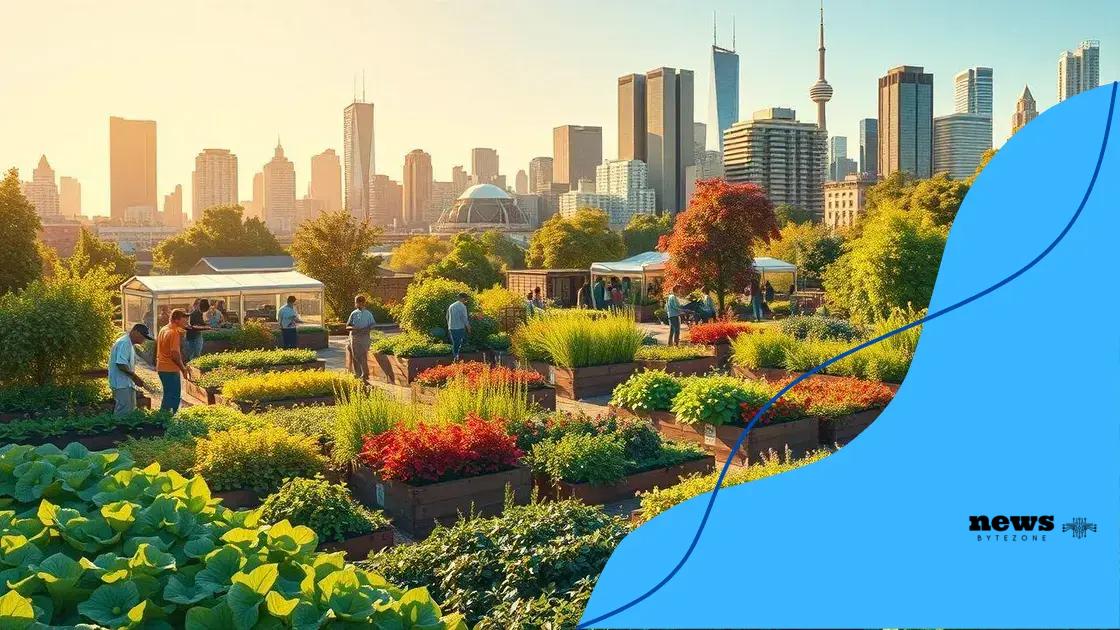Urban farming initiatives enhance food security by utilizing limited urban spaces for cultivation, implementing innovative techniques like hydroponics, and fostering community engagement while addressing challenges like regulatory barriers and resource access.
Urban farming initiatives are changing the way we think about food security in cities. They offer innovative solutions to enhance local food production while promoting community engagement. Curious about how these initiatives work? Let’s dive in!
What are urban farming initiatives?
Urban farming initiatives are innovative projects that bring agriculture into cities. They transform vacant lots, rooftops, and community spaces into green havens. With a focus on local food production, these initiatives are designed to meet the growing need for fresh, accessible food in urban areas.
Types of Urban Farming
Urban farming can take many forms. Each type serves a unique purpose and contributes to community resilience. Some common types include:
- Community gardens: These are shared spaces where residents can grow vegetables and flowers.
- Rooftop gardens: Utilizing building rooftops, these gardens maximize space and provide fresh produce.
- Vertical farming: Indoor farms that stack layers of crops, optimizing limited space.
Through these methods, urban farming not only provides food but also enhances local ecosystems. They help combat urban heat islands and improve air quality.
In addition to food production, urban farms foster community engagement and education. Workshops can teach residents about sustainable practices and nutrition. Schools often partner with these gardens to create hands-on learning opportunities.
Benefits of Urban Farming
There are numerous benefits to urban farming initiatives. They create job opportunities, support local economies, and improve food security. Moreover, urban farms can:
- Reduce food miles: Shortening the distance food travels helps decrease carbon emissions.
- Promote biodiversity: They offer habitats for various species, helping to restore local ecosystems.
- Enhance community well-being: Green spaces provide areas for relaxation and social interaction.
Overall, urban farming initiatives play a critical role in shaping sustainable cities. They encourage self-reliance and improve the overall quality of life for urban residents. As these projects grow in popularity, they pave the way for a greener future, proving that cities can indeed nourish their inhabitants.
Benefits of urban farming for communities
Urban farming provides numerous benefits for communities, transforming both social dynamics and the environment. These initiatives create opportunities for residents to come together and share resources, fostering a sense of belonging and cooperation.
Improved Food Security
One of the primary benefits of urban farming is the enhancement of food security within neighborhoods. By growing food locally, communities can reduce dependency on external food sources. This not only ensures access to fresh produce but also helps lower prices.
- Access to fresh vegetables: Urban farms provide a variety of fresh options that may not be readily available in local stores.
- Reduction in food deserts: These initiatives help fill gaps where access to healthy food is limited.
- Educational programs: Many urban farms offer workshops on nutrition and gardening, which educate community members about healthy eating.
These aspects contribute to the overall health of community members and empower them to make better food choices.
Environmental Benefits
Urban farming also plays a critical role in creating a healthier urban environment. By integrating green spaces into cities, these initiatives help combat issues like air pollution and the urban heat island effect. Plants absorb carbon dioxide and release oxygen, improving air quality.
Furthermore, urban farms promote biodiversity by providing habitats for insects and wildlife. They can utilize rainwater harvesting and composting practices, which are sustainable and eco-friendly. This not only reduces waste but also enhances the ecosystem.
Community Engagement
Engagement is another vital benefit. Urban farming initiatives stimulate social interaction, giving residents a shared purpose. These spaces often become venues for community events, such as farmer’s markets or festivals. Local gatherings centered around food can strengthen ties among residents, creating a supportive network.
The collaborative nature of urban farming allows residents to take ownership of their spaces. They can work together to maintain gardens, share knowledge, and celebrate their successes. These interactions help cultivate trust and cooperation in the community.
Case studies of successful urban farming

Exploring case studies of successful urban farming reveals the innovative approaches cities are taking to boost food production and community well-being. These examples highlight how urban agriculture can thrive in various environments.
New York City Urban Agriculture
In New York City, community gardens have flourished in many neighborhoods, turning abandoned lots into productive green spaces. The GreenThumb program supports over 600 community gardens across the city. These gardens offer fresh fruits and vegetables to local residents, promoting health and nutrition.
- Crop diversity: Gardens grow a wide variety of crops, accommodating different cultural preferences.
- Community events: Many gardens host workshops and events, increasing community engagement.
- Environmental impact: They help mitigate urban heat while improving air quality.
Through these initiatives, New Yorkers are not only growing food but also building strong community ties.
Detroit’s Urban Farming Revolution
Detroit has become a notable example of urban farming transformation. Facing economic challenges, the city turned to agriculture as a means of revitalization. Organizations like Featured Gardens have created urban farms that bring fresh produce to residents and stimulate local economies.
These farms utilize vacant lots to grow vegetables and herbs, providing job opportunities for locals. They also promote entrepreneurship by allowing individuals to sell their produce in local markets. This approach fosters self-sufficiency and empowers community members.
Toronto’s Urban Agriculture Guidelines
In Toronto, a strong emphasis on urban agriculture is evident through the Toronto Urban Agriculture Action Plan. This initiative encourages the creation of community gardens, rooftop farms, and vertical gardens. The city aims to integrate food production into urban planning.
- Policy support: The city provides resources and funding to budding urban farmers.
- Education programs: Workshops and training enhance skills related to urban farming.
- Sustainability focus: Initiatives encourage organic farming methods and water conservation.
Through these strategic efforts, Toronto is working towards becoming a resilient and food-secure city.
These case studies showcase the diverse methods and strategies that urban areas are using to promote agriculture. Each success story not only demonstrates the potential of urban farming but also highlights the importance of community involvement and sustainable practices.
Challenges faced by urban farmers
Despite the many benefits of urban farming, there are significant challenges that urban farmers must navigate. These challenges can impact the sustainability and growth of urban agricultural initiatives.
Space Limitations
One major issue is the limited availability of space in urban areas. Many cities have high population densities, making it difficult to find suitable land for farming. This limitation often leads to competition for space among developers, residents, and farmers. Urban farmers must become creative in using small plots, rooftops, and vertical spaces to maximize production.
- Rooftop gardens: These provide an innovative solution but require structural support.
- Community gardens: Often depend on shared interests to maintain.
- Basement farms: Indoor farming can solve space issues but needs proper lighting and ventilation.
As urban populations continue to grow, addressing these space issues becomes crucial for the success of urban farming.
Regulatory and Zoning Issues
Another challenge urban farmers face is navigating regulations and zoning laws. Many cities have strict rules about land use that can limit farming activities. Farmers need to understand local laws regarding zoning, land ownership, and business permits.
These regulatory barriers can hinder growth and innovation. Furthermore, farmers may experience difficulties when trying to obtain funding or grants due to the lack of clear policies supporting urban agriculture. Engaging with local governments and community leaders can help advocate for more favorable regulations.
Pests and Diseases
Pests and diseases pose significant risks to urban farms. In densely populated areas, the spread of pests can be rapid, resulting in damage to crops. Urban farmers must adopt integrated pest management practices to protect their plants effectively. This often includes:
- Natural pest control: Using beneficial insects to manage pest populations.
- Healthy soil: Practicing crop rotation to enhance soil health.
- Monitoring and research: Remaining vigilant and researching local pest habits.
By proactively managing these challenges, urban farmers can enhance their resilience and productivity.
Access to Resources
Access to resources such as water, seeds, and soil can also be challenging for urban farmers. Water scarcity and rising costs can limit production capabilities. Additionally, finding quality seeds and materials in urban settings may require significant effort.
Community support and local partnerships can play a vital role in overcoming these resource barriers. Collaborating with local businesses and nonprofits can provide farmers access to necessary resources and foster a sense of community.
The future of urban agriculture
The future of urban agriculture holds great promise as cities adapt to growing populations and changing climates. Innovations in farming practices, technology, and community engagement are paving the way for more sustainable food systems.
Innovative Farming Techniques
Urban farmers are increasingly adopting innovative techniques such as vertical farming and hydroponics. These methods allow for maximum food production in limited spaces. Vertical farms can be built in warehouses, making use of space efficiently and reducing the need for transportation.
- Hydroponics: This soil-less method uses nutrient-rich water to grow plants.
- Aeroponics: Similar to hydroponics but uses a mist to deliver nutrients.
- Smart technology: Utilizing sensors and automation can enhance growing conditions.
These advancements enable cities to produce food more effectively while using less water and land.
Emphasis on Sustainability
As awareness of climate change grows, sustainability becomes central to the future of urban agriculture. Farmers are focusing on practices that benefit the environment and promote biodiversity. Community-supported agriculture (CSA) models can link consumers directly to local producers, reducing the carbon footprint associated with food transport.
Planting native species and practicing organic farming can enhance ecosystem health. Urban farms contribute to local pollinator populations and improve air quality. These practices ensure that urban agriculture can thrive sustainably.
Community Collaboration
The future of urban agriculture is also about community involvement. Engaging local residents in farming initiatives fosters a sense of ownership and helps build resilient communities. Workshops and educational programs can empower individuals with the skills needed to grow their food.
Collaboration among various stakeholders, including local governments, non-profits, and businesses, will be essential. By pooling resources and knowledge, urban agriculture can become a significant fixture in cities, providing fresh and healthy food options.
Policy Support and Regulation
In order to thrive, urban agriculture needs supportive policies that facilitate growth. Cities can create incentives for urban gardens and farms, such as tax breaks or grants. Zoning laws should be adjusted to allow for more urban farming projects, removing barriers that prevent access to land.
With better policies, urban farmers can expand their operations and contribute more significantly to local food systems. By integrating agriculture into urban planning, cities can secure food production as a vital part of their infrastructure.
The future of urban agriculture looks bright, filled with innovative solutions to enhance sustainability and community involvement. As cities continue to grow, urban farms will play a crucial role in feeding populations while strengthening local communities. With advancements in technology, environmental practices, and supportive policies, urban farmers will be better equipped to tackle challenges and thrive. Embracing these changes allows cities to create greener, healthier environments for everyone.
FAQ – Questions about Urban Agriculture
What is urban agriculture?
Urban agriculture refers to the practice of cultivating food in urban areas, utilizing vacant lots, rooftops, and community spaces to grow fresh produce.
What are the benefits of urban agriculture?
Urban agriculture enhances food security, promotes sustainability, fosters community engagement, and reduces carbon footprints associated with food transport.
What challenges do urban farmers face?
Urban farmers encounter challenges such as limited space, regulatory barriers, pest control, and access to resources like water and quality seeds.
How can urban agriculture be supported?
Support can come from community involvement, favorable policies, and collaboration among local governments, businesses, and residents to foster growth in urban farming initiatives.

 Virtual reality in journalism: immersive storytelling techniques
Virtual reality in journalism: immersive storytelling techniques  The impact of 5G on rural connectivity and development
The impact of 5G on rural connectivity and development  Space tourism: preparing for an amazing journey
Space tourism: preparing for an amazing journey